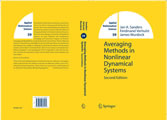Suchen und Finden
Preface
6
Preface to the Revised 2nd Edition
6
Preface to the First Edition
7
List of Figures
9
List of Tables
11
List of Algorithms
12
Contents
13
Map of the book
20
1 Basic Material and Asymptotics
21
1.1 Introduction
21
1.2 The Initial Value Problem: Existence, Uniqueness and Continuation
22
1.3 The Gronwall Lemma
24
1.4 Concepts of Asymptotic Approximation
25
1.5 Naive Formulation of Perturbation Problems
32
1.6 Reformulation in the Standard Form
36
1.7 The Standard Form in the Quasilinear Case
37
2 Averaging: the Periodic Case
40
2.1 Introduction
40
2.2 Van der Pol Equation
41
2.3 A Linear Oscillator with Frequency Modulation
43
2.4 One Degree of Freedom Hamiltonian System
44
2.5 The Necessity of Restricting the Interval of Time
45
2.6 Bounded Solutions and a Restricted Time Scale of Validity
46
2.7 Counter Example of Crude Averaging
47
2.8 Two Proofs of First-Order Periodic Averaging
49
2.9 Higher-Order Periodic Averaging and Trade-Off
56
3 Methodology of Averaging
64
3.1 Introduction
64
3.2 Handling the Averaging Process
64
3.3 Averaging Periodic Systems with Slow Time Dependence
71
3.4 Unique Averaging
75
3.5 Averaging and Multiple Time Scale Methods
79
4 Averaging: the General Case
85
4.1 Introduction
85
4.2 Basic Lemmas; the Periodic Case
86
4.3 General Averaging
90
4.4 Linear Oscillator with Increasing Damping
93
4.5 Second-Order Approximations in General Averaging; Improved First- Order Estimate Assuming Differentiability
95
4.6 Application of General Averaging to Almost- Periodic Vector Fields
100
5 Attraction
106
5.1 Introduction
106
5.2 Equations with Linear Attraction
107
5.3 Examples of Regular Perturbations with Attraction
110
5.4 Examples of Averaging with Attraction
113
5.5 Theory of Averaging with Attraction
117
y
118
( t)
118
x(0) y(t)
118
y
118
( t)
118
y
118
( t) x( t)
118
5.6 An Attractor in the Original Equation
120
5.7 Contracting Maps
121
5.8 Attracting Limit-Cycles
123
5.9 Additional Examples
124
6 Periodic Averaging and Hyperbolicity
128
6.1 Introduction
128
6.2 Coupled Duffing Equations, An Example
130
6.3 Rest Points and Periodic Solutions
133
6.4 Local Conjugacy and Shadowing
136
6.5 Extended Error Estimate for Solutions Approaching an Attractor
145
6.6 Conjugacy and Shadowing in a Dumbbell-Shaped Neighborhood
146
6.7 Extension to Larger Compact Sets
152
6.8 Extensions and Degenerate Cases
155
7 Averaging over Angles
158
7.1 Introduction
158
7.2 The Case of Constant Frequencies
158
7.3 Total Resonances
163
7.4 The Case of Variable Frequencies
167
7.5 Examples
169
7.6 Secondary (Not Second Order) Averaging
173
7.7 Formal Theory
174
7.8 Systems with Slowly Varying Frequency in the Regular Case; the Einstein Pendulum
176
7.9 Higher Order Approximation in the Regular Case
180
7.10 Generalization of the Regular Case; an Example from Celestial Mechanics
183
8 Passage Through Resonance
188
8.1 Introduction
188
8.2 The Inner Expansion
189
8.3 The Outer Expansion
190
8.4 The Composite Expansion
191
8.5 Remarks on Higher-Dimensional Problems
192
8.6 Analysis of the Inner and Outer Expansion; Passage through Resonance
196
8.7 Two Examples
205
9 From Averaging to Normal Forms
210
9.1 Classical, or First-Level, Normal Forms
210
9.2 Higher Level Normal Forms
219
10 Hamiltonian Normal Form Theory
222
10.1 Introduction
222
10.2 Normalization of Hamiltonians around Equilibria
227
10.3 Canonical Variables at Resonance
231
10.4 Periodic Solutions and Integrals
232
10.5 Two Degrees of Freedom, General Theory
233
10.6 Two Degrees of Freedom, Examples
240
10.7 Three Degrees of Freedom, General Theory
255
10.8 Three Degrees of Freedom, Examples
266
11 Classical (First–Level) Normal Form Theory
280
11.1 Introduction
280
11.2 Leibniz Algebras and Representations
281
11.3 Cohomology
284
11.4 A Matter of Style
286
11.5 Induced Linear Algebra
291
11.6 The Form of the Normal Form, the Description Problem
298
12 Nilpotent (Classical) Normal Form
301
12.1 Introduction
301
12.2 Classical Invariant Theory
301
12.3 Transvectants
302
12.4 A Remark on Generating Functions
306
12.5 The Jacobson–Morozov Lemma
309
12.6 A GL
310
-Invariant Description of the First Level
310
Normal Forms for n < 6
310
12.7 A GL
326
-Invariant Description of the Ring of
326
Seminvariants for n 6
326
13 Higher–Level Normal Form Theory
331
13.1 Introduction
331
13.2 Abstract Formulation of Normal Form Theory
333
13.3 The Hilbert–Poincar e Series of a Spectral Sequence
336
13.4 The Anharmonic Oscillator
337
13.5 The Hamiltonian 1 : 2-Resonance
342
13.6 Averaging over Angles
344
13.7 Definition of Normal Form
345
13.8 Linear Convergence, Using the Newton Method
346
13.9 Quadratic Convergence, Using the Dynkin Formula
350
A The History of the Theory of Averaging
352
A.1 Early Calculations and Ideas
352
A.2 Formal Perturbation Theory and Averaging
355
A.3 Proofs of Asymptotic Validity
358
B A 4-Dimensional Example of Hopf Bifurcation
359
B.1 Introduction
359
B.2 The Model Problem
360
B.3 The Linear Equation
361
B.4 Linear Perturbation Theory
362
B.5 The Nonlinear Problem and the Averaged Equations
364
C Invariant Manifolds by Averaging
367
C.1 Introduction
367
C.2 Deforming a Normally Hyperbolic Manifold
368
C.3 Tori by Bogoliubov-Mitropolsky-Hale Continuation
370
C.4 The Case of Parallel Flow
371
C.5 Tori Created by Neimark–Sacker Bifurcation
374
D Some Elementary Exercises in Celestial Mechanics
377
D.1 Introduction
377
D.2 The Unperturbed Kepler Problem
378
D.3 Perturbations
379
D.4 Motion Around an ‘Oblate Planet’
380
D.5 Harmonic Oscillator Formulation for Motion Around an ‘ Oblate Planet’
381
D.6 First Order Averaging for Motion Around an ‘ Oblate Planet’
382
D.7 A Dissipative Force: Atmospheric Drag
385
D.8 Systems with Mass Loss or Variable G
387
D.9 Two-body System with Increasing Mass
390
E On Averaging Methods for Partial Differential Equations
391
E.1 Introduction
391
E.2 Averaging of Operators
392
E.3 Hyperbolic Operators with a Discrete Spectrum
397
E.4 Discussion
408
References
409
Index of Definitions & Descriptions
426
General Index
430
Alle Preise verstehen sich inklusive der gesetzlichen MwSt.























